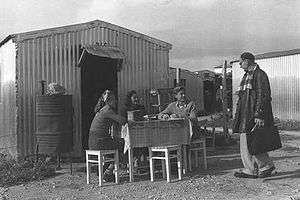Development town

Development town (Hebrew: עיירת פיתוח, Ayarat Pitu'ah) is a term used to refer to the new settlements that were built in Israel during the 1950s in order to provide permanent housing to a large influx of Jewish refugees from Arab countries, Holocaust survivors from Europe and other new immigrants (Olim), who arrived to the newly established State of Israel. The towns were designated to expand the population of the country's peripheral areas and to ease development pressure on the country's crowded centre. The towns are the results of the Sharon plan - the master plan of Israel. The majority of such towns were built in the Galilee in the north of Israel, and in the northern Negev desert in the south. In addition to the new towns, Jerusalem was also given development town status in the 1960s.[1]
In the context of the Arab-Israeli conflict, Jewish refugees were initially resettled in refugee camps known variously as Immigrant camps, Ma'abarot, and "development towns" prior to absorption into mainstream Israeli society. Conversely, many Palestinian refugees remain settled in Palestinian refugee camps, while others have been absorbed into Jordanian society or the Palestinian territories. Since 1948, the sovereign State of Israel has guaranteed asylum and citizenship to Jewish refugees.
Background
| Jewish exodus from Arab and Muslim countries |
|---|
 |
| Communities |
| Background |
| Main events |
| Resettlement |
| Advocation |
| Related topics |

The sudden arrival of over 130,000 Iraqi Jews in Israel in the early 1950s meant that almost a third of Ma'abarah dwellers were of Iraqi Jewish origin. At the end of 1949 there had been 90,000 Jews housed in Ma'abarot; by the end of 1951 this population rose to over 220,000 people, in about 125 separate communities.[2] Ma'abarot residents were housed in tents or in temporary tin dwellings. Over 80% of the residents were Jewish refugees from Arab and Muslim countries of Middle East and North Africa. The number of people housed in Ma'abarot began to decline in 1952, and the last Ma'abarot were closed sometime around 1963.[2] Over time, the Ma'abarot metamorphosed into Israeli towns, or were absorbed as neighbourhoods of the towns they were attached to, and residents were provided with permanent housing. Most of the Ma'abarah camps transformed into development towns. Ma'abarot, which became development towns, include Kiryat Shmona, Sderot, Beit She'an, Yokneam, Or Yehuda and Migdal HaEmek.
Establishment
The first development town was Beit Shemesh, founded in 1950 around 20 km from Jerusalem. The newly established towns were mostly populated by Jewish refugees from Arab and Muslim countries - Morocco, Iraq, Iran, Egypt, Libya, Yemen, Syria and Tunisia. Development towns were also populated by Holocaust survivors from Europe and Jewish immigrants, who came to the newly established State of Israel.
Development town status
A high proportion of the population is religious or traditional, with a 2003 survey showing that 39% of residents would rather Israel be run more by halakhic law.[3]
Despite businesses and industries being eligible for favorable tax treatment and other subsidies, with the exception of Arad, most of the towns (particularly those in the south) have fared poorly in the economic sense, and often feature amongst the poorest Jewish Areas in Israel.[4]
In 1984, the Development Towns project was awarded the Israel Prize for its special contribution to society and the State of Israel.[5]
During the 1990s
| Aliyah |
|---|
 |
| Jewish immigration to the Land of Israel |
| Pre-Zionist |
| To Ottoman Syria |
| To Mandatory Palestine |
| To the State of Israel |
| Concepts |
| Persons and organizations |
| Related topics |
|
|
|
Many towns gained a new influx of residents during the mass immigration from former Soviet states in the early 1990s.[6]
List of development towns
|
Center |
Galilee and Valleys |
See also
References
- ↑ Teddy Kollek and his life-long dedication Jerusalem Post, 2 January 2007
- 1 2 (Hebrew) Ma'abarot by Miriam Kachenski, Israeli Center for Educational Technology
- ↑ We're not Kach , but we love Kahane Haaretz
- ↑ Full On Location: The deep south Jerusalem Post, 27 December 2007
- ↑ "Israel Prize Official Site - Recipients in 1984 (in Hebrew)".
- ↑ Israel's battered economy BBC News, 21 June 2002